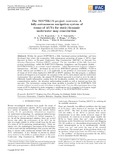| dc.contributor.author | Kapoutsis, A. Ch. | |
| dc.contributor.author | Salavasidis, G. V. | |
| dc.contributor.author | Chatzichristofis, Savvas A. | |
| dc.contributor.author | Braga, J. | |
| dc.contributor.author | Pinto, J. | |
| dc.contributor.author | Borges de Sousa, Joao | |
| dc.contributor.author | Kosmatopoulos, E. B. | |
| dc.date.accessioned | 2017-11-02T11:17:03Z | |
| dc.date.available | 2017-11-02T11:17:03Z | |
| dc.date.issued | 2015 | |
| dc.identifier.citation | IFAC-PapersOnLine 48-2 (2015) 231–237 | en_UK |
| dc.identifier.uri | http://hdl.handle.net/11728/10217 | |
| dc.description.abstract | Within the project NOPTILUS, a fully functional system/methodology had been
developed that allows the cooperative, fully-autonomous navigation of teams of AUVs when
deployed in Static or Dynamic Underwater Map Construction (SDUMC) or Dynamic Underwater
Phenomena Tracking (DUPT) missions. The key ingredient of this fully functional
system/methodology (called the NOPTILUS Planning, Assignment and Navigation Module {
NOPTILUS PAN) is an optimal control algorithm { called Parametrized Cognitive Adaptive
Optmization { (PCAO) { developed by one of the NOPTILUS partners (CERTH). PCAO is
rstly tailored and modi ed so as to be applicable to the problem of autonomous navigation
of teams of AUVs when deployed in SDUMC or DUPT missions. For this purpose, a nonlinear
model is developed so as to capture the dynamics of the AUVs, their sensors and the underwater
environment. More precisely, the original PCAO-based approach is revised so as to be able to
e ciently handle information coming from the localization module, the underwater acoustic
communication module, the situation understanding module as well as instructions from the
operator. The information coming from these modules is handled by the NOPTILUS PAN
module without the need to enter in tedious re-design tasks. Two real-life experiments (involving
teams of AUVs deployed in static mapping or simultaneous static mapping and dynamic target
taking) demonstrate the e ciency and practicability of the NOPTILUS PAN module. | en_UK |
| dc.language.iso | en | en_UK |
| dc.publisher | IFAC (International Federation of Automatic Control) | en_UK |
| dc.relation.ispartofseries | «IFAC Workshop on Navigation, Guidance and Control of Underwater Vehicles (NGCUV’2015);Girona – Catalonia (Spain), April 28-30 2015 | |
| dc.rights | © IFAC 2015 | en_UK |
| dc.rights.uri | http://creativecommons.org/licenses/by-nc-nd/4.0/ | en_UK |
| dc.source.uri | http://www.sciencedirect.com/science/article/pii/S2405896315002773 | en_UK |
| dc.subject | Research Subject Categories::TECHNOLOGY | en_UK |
| dc.subject | SLAM-TT | en_UK |
| dc.subject | Exploration | en_UK |
| dc.subject | Path Planning for Multiple Mobile Robot Systems | en_UK |
| dc.subject | Trajectory Generation | en_UK |
| dc.subject | Cognitive Robotics | en_UK |
| dc.subject | Mapping | en_UK |
| dc.subject | Marine Robotics | en_UK |
| dc.title | The NOPTILUS project overview: A fully-autonomous navigation system of teams of AUVs for static/dynamic underwater map construction | en_UK |
| dc.type | Working Paper | en_UK |


